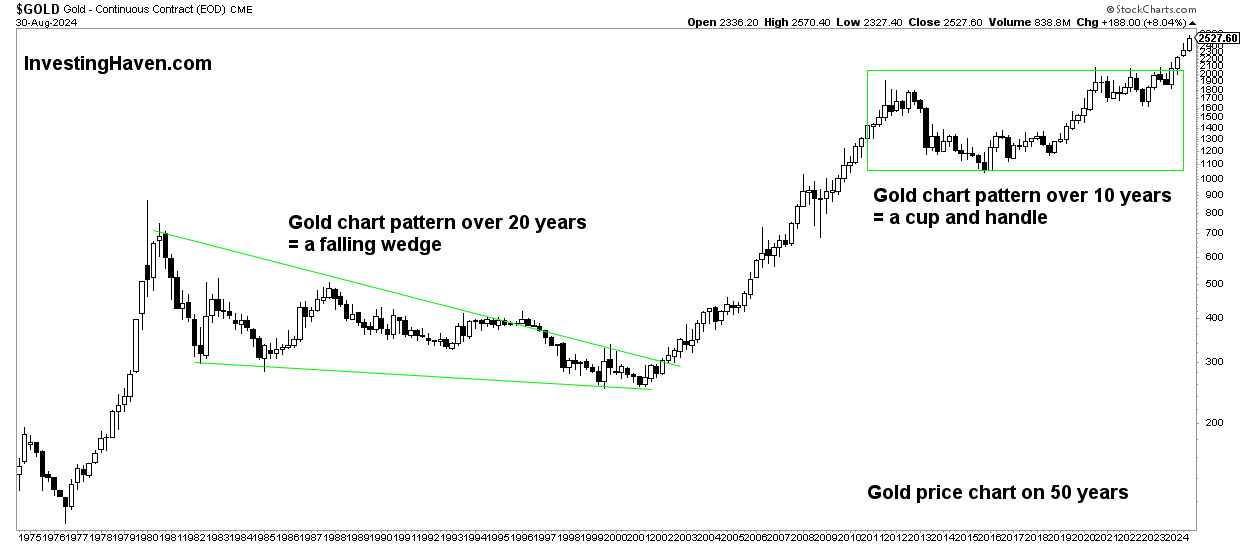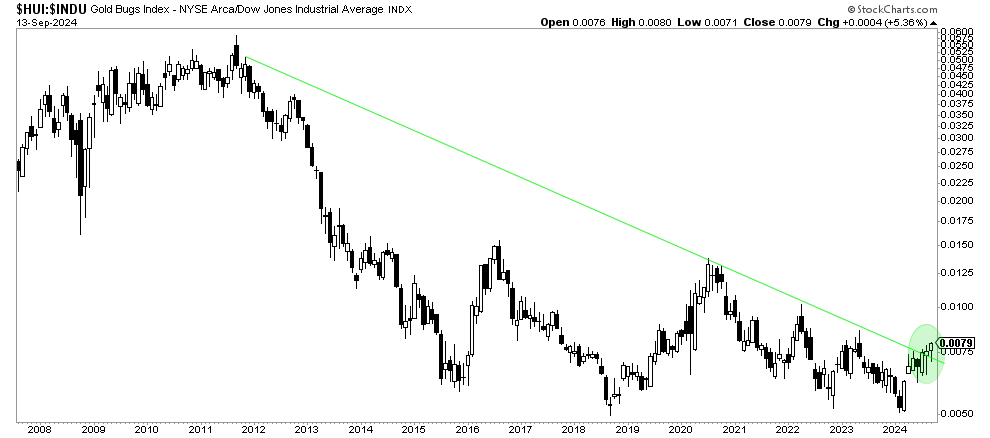Gold is known to be a safe haven asset, particularly during periods of uncertainty. Concurrently, gold is known to be an inflation hedge.
For conservative investors, gold presents an opportunity, especially in the current financial landscape which has a little bit of both: uncertainty and continued inflation fears.
With a persistent bullish gold market trend in 2024, it’s crucial to understand how gold and gold-related investments can offer stability and potential growth to conservative investors.
This article explores why gold is gaining traction, focusing on its role as a reliable asset class and the opportunities it presents for cautious investors.
Understanding Gold’s Bull Market Trend
The gold market is currently experiencing bullish momentum.
This shift is marked by a long-term chart dynamics. For conservative investors, this trend is an encouraging sign. It suggests that gold is not just a hedge against inflation and market volatility but also a viable asset for long-term wealth preservation.
As explained in great detail in this gold price prediction, gold’s recent performance is reflective of broader economic conditions. Central banks around the world have been increasing their gold reserves, a move that supports gold prices and signals confidence in the asset’s future potential.
This global trend is further supported by mildly rising inflation expectations, which historically boost gold prices.
For conservative investors, this means that gold is likely to continue its upward trend, making it a compelling investment case.
Moreover, with long term seasonality dynamics providing tailwinds for gold investors, it looks like gold may continue to do well in the coming months. Below is the 20-year gold seasonality chart:

Gold as a Stable Asset Class
Gold’s role as a stable asset class is well-documented. Unlike stocks and bonds, gold does not generate income or dividends, but it offers a hedge against economic downturns and inflation. This characteristic makes gold an attractive option for conservative investors looking to diversify their portfolios.
The current gold bull market reinforces this view. The precious metal’s decisive breakout above its former all-time highs indicates a robust upward momentum.
This trend is supported by various factors, including global geopolitical uncertainty and increased demand from central banks. Moreover, with rate cuts looming across the globe, the trends in the real inflation rate are in favor of gold.
For investors seeking stability, gold’s performance provides a reassuring indicator of its value.
This is the 50-year gold price chart exhibiting major cycles and bull/bear markets:

Opportunities in Gold Bullion and Low-Risk Gold Miners
For conservative investors, gold bullion and low-risk gold miners present promising opportunities.
Gold bullion, in the form of physical bars or coins, offers direct exposure to gold’s price movements. It is a tangible asset that can be stored securely, making it an ideal choice for those who prefer a straightforward investment approach.
In addition to bullion, low-risk gold mining companies offer another avenue for investment. These companies, often referred to as senior gold producers, are less volatile compared to smaller, speculative miners. They have established operations and a track record of stable production, which reduces investment risk.
As the gold market recovers, these companies are well-positioned to benefit from rising gold prices, making them an attractive option for conservative investors.
Gold Mining Charts and Market Indicators
The recent breakout in gold mining indices further supports the positive outlook for gold investments.
The HUI gold bug index, which tracks the performance of major gold mining companies, has broken out from a 12-year downtrend. This technical signal indicates a strong bullish trend, suggesting that gold mining stocks are likely to continue their upward momentum.
This is the HUI Gold Bug Index priced in the large cap Dow Jones Index (HUI to Dow ratio):

Clearly, momentum is kicking into gold miners, a lagging segment in financial markets, now about to turn their 12-year lagging trend.
Similarly, the GDX ETF, which represents a broader range of gold mining companies, is experiencing a significant rebound. Although short-term fluctuations are expected, the long-term trend remains positive.
For conservative investors, this reinforces the potential value in investing in gold miners, traditionally a very volatile market segment, now supported by a secular gold bull market.
The Role of Conservative Investing in Gold
For conservative investors, the key to capitalizing on the gold bull market is to focus on stability and risk management. Investing in gold bullion provides a direct hedge against inflation and geopolitical instability.
At the same time, low-risk gold mining companies offer exposure to the gold market with reduced volatility compared to more speculative ventures.
By incorporating gold into their investment portfolios, conservative investors can achieve a balanced approach that combines stability with growth potential.
The current gold bull market trend, supported by favorable macro conditions and strong demand, presents an opportune moment to consider gold as a core asset class.
Gold’s Long Term Potential
Gold’s bullish trend and its role as a stable asset class make it an appealing choice for conservative investors.
The recent breakout in gold prices and gold mining indices, coupled with strong fundamental drivers such as rising inflation expectations and increased central bank purchasing, highlight the metal’s potential for continued growth.
For those looking to enhance their portfolios with a reliable and resilient asset, gold offers a valuable option. Whether through physical bullion or investments in low-risk gold miners, incorporating gold into your investment strategy can provide both security and growth potential.
As always, it is essential to stay informed and consider how gold fits within your overall investment strategy.
